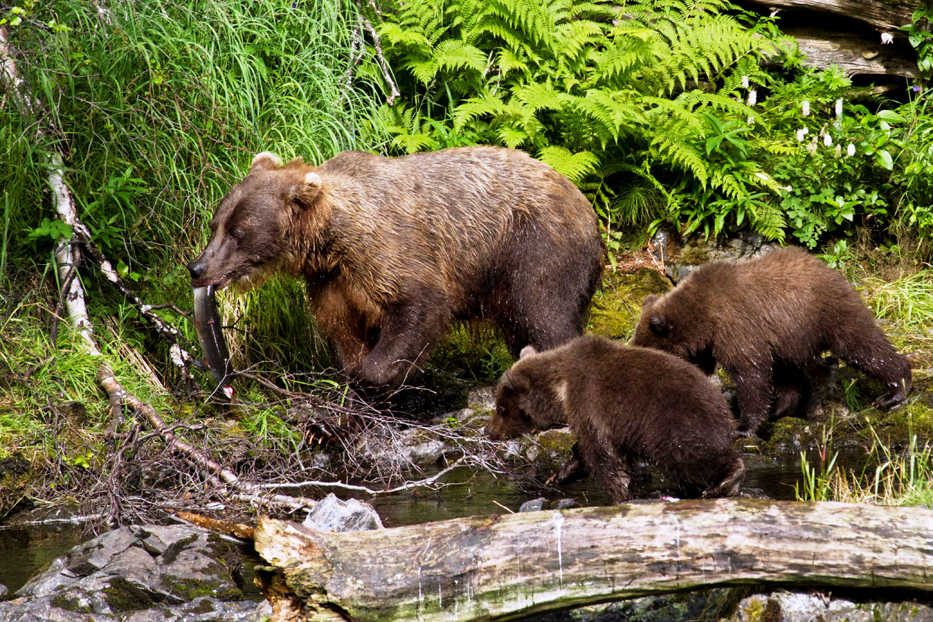As early runs of king and sockeye return to streams of the Kenai Peninsula, they bring more than the roe and milt that brings about the cycle of life. The very nature of anadromous fish is that they also carry the carbon, nitrogen, phosphorus and other minerals stored in their bodies after years of growing in the high seas.
Their hoped-for evolutionary fate is to die after successfully spawning. But along the way, nutrients stored in their bodies and roe are excreted by live salmon and released from decomposing carcasses, energizing a complex food web that includes phytoplankton, benthic invertebrates, predators, scavengers, riparian vegetation, and even song bird populations. Called “marine-derived nutrients” (or MDN), it is the mechanism by which salmon link marine and terrestrial ecosystems via a freshwater conduit that is truly cosmic — literally, what goes around comes around.
Consider that an adult chum salmon returning to spawn contains 130 grams of nitrogen and 20 grams of phosphorus. I couldn’t find comparable data for sockeye but, for the sake of argument, let’s say they’re the same. With a late run of 1.7 million sockeye in the Kenai River, that translates to a potential input of half-a-million pounds of nitrogen and 75,000 pounds of phosphorus into the watershed every year!
MDN can be tracked through the food web by examining the ratios of stable isotope tracers, typically of carbon or nitrogen, and sometimes sulfur. The relative contribution of these elements from marine versus freshwater nutrient sources can assessed because spawning salmon contain higher proportions of the heavier isotopic form (more neutrons). What’s cool is that there has been some great research on MDN here on the Kenai Peninsula.
Dr. Dan Rinella, originally with the University of Alaska Anchorage and now with the U.S. Fish and Wildlife Service, worked with others on several streams on the western Kenai Peninsula to demonstrate that MDN in aquatic macroinvertebrates and juvenile Dolly Varden increased with increasing salmon returns. In other words, these organisms respond positively to MDN transported into the freshwater environment by returning salmon. More impressive was that elevated MDN levels were maintained in these organisms for at least nine months after spawning, indicating that today’s returns affect the next growing season.
And, of course, other fish eat these nutrient-enhanced invertebrates as well as roe. A researcher in Washington found that juvenile coho doubled their growth rate after returning adults spawned whereas the growth rate of juvenile trout in nearby non-anadromous streams remained the same. I found one National Park Service presentation online that suggested up to 95 percent of food consumed by a salmon fry may have originated from the salmon carcasses of its “parents”!
This nutrient multiplier effect carries over to riparian vegetation, a beneficiary of scavenging and fishing eagles, bears, ravens, gulls, river otters and mink, all of which leave salmon remains on stream banks. For example, a study published in the journal Ursus by Dr. Grant Hilderbrand and others found that 15 to 18 percent of nitrogen in white spruce within 500 meters of Mystery Creek and the Killey River, two anadromous streams on the Kenai National Wildlife Refuge, were marine-derived. Research elsewhere indicates 10 to 70 percent of nitrogen in riparian foliage comes from salmon. This fertilizer effect means that foliage grows faster and presumably lusher — a study on Chichigof Island in Southeast Alaska found that Sitka spruce growth rates were three times faster at spawning sites than non-spawning sites.
You might guess that richer riparian vegetation, nutrient-enhanced invertebrates, and abundant salmon carcasses would affect song bird populations as well. Indeed, a study of salmon streams in coastal British Columbia found that breeding densities of winter wren, Swainson’s thrush, varied thrush, Pacific-slope flycatcher, and golden-crowned kinglet were about half on stream reaches above waterfalls (without salmon) as those below waterfalls (with salmon).
I encourage you to take a look at “Salmon in the Trees”, a book with wonderful illustrations and photographs about the role that salmon (and MDN) plays in sustaining the Tongass rainforest ecosystem in Southeast Alaska. It gives one pause as we go about our seasonal business of using gill nets and fishing lines and dipnets to intercept salmon returning to Kenai ecosystems. Our harvest today may well affect the productivity of our salmon tomorrow — yet another reminder of what goes around comes around.
Dr. John Morton is the supervisory biologist at Kenai National Wildlife Refuge. Find more information at http://www.fws.gov/refuge/kenai/ or http://www.facebook.com/kenainationalwildliferefuge.

